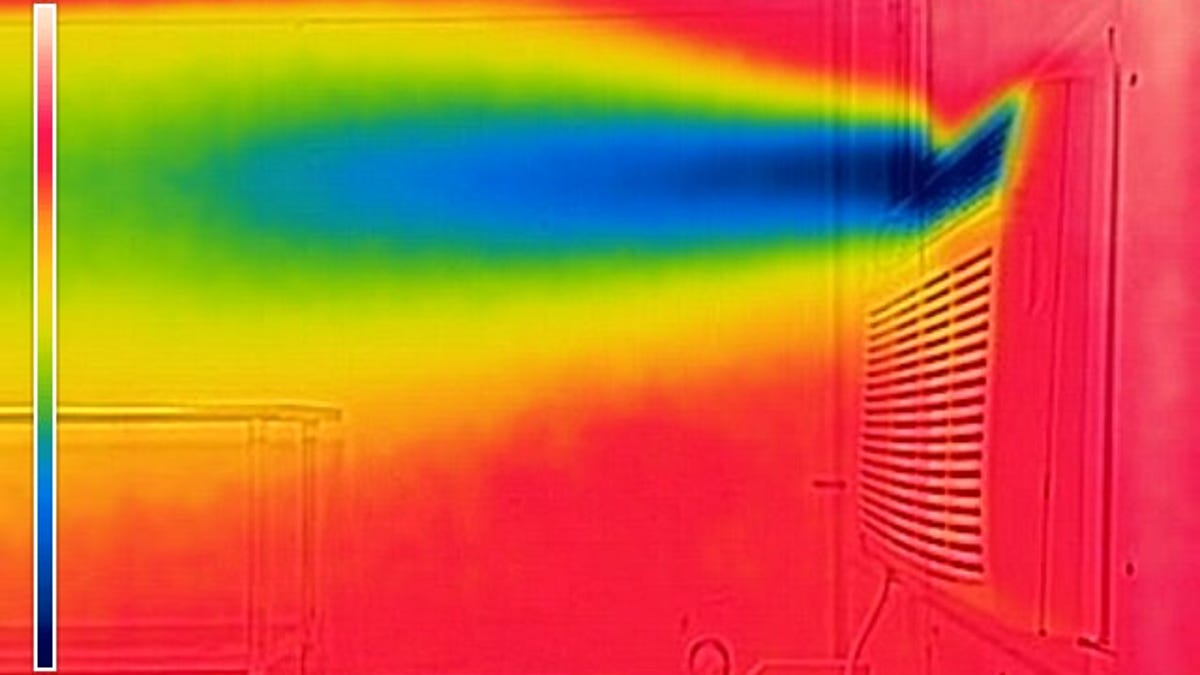It's Not a Giant Ice Cube: Here's How an Air Conditioner Works to Cool Your Home
Learn how air conditioners keep you cool when it's hot outside.

Here's a thermal profile view of a window AC unit cooling the surrounding air.
Of the last 142 years, nine of the 10 warmest Junes have occurred since 2010, with this June being the fifth warmest. These boiling temperatures have people scrambling for relief, often in the comfort of their own homes. That is, assuming you're outfitted with some type of air conditioning -- and according to Bloomberg, that's about 90% of US homes.
The question is, in such intense heat, how do air conditioners actually work to cool the air we experience inside our homes? The answer isn't too complicated, so let's dig in.
We're all familiar with the most common component of your home's cooling system: the thermostat. This is a front where many wars have been waged over the years. The never-ending battle for control of the thermostat could easily show up in Marvel's next releases as a showdown between the partner who's too frugal and the one who's always cold. But this is where the action begins. It's sweltering outside, so you lower the target temp on your cooling system. Now what?
Central air
In the most common residential central cooling setup, you have both an indoor and outdoor unit, sometimes referred to as the evaporator and condenser units. Each unit has a fan and a set of coils. These coils are connected tubing with a type of refrigerant flowing between the two units. The outdoor unit also has a compressor and these components all work together to quickly change the refrigerant back and forth from liquid to gas.
The compressor raises the pressure and temperature of the refrigerant gas and, acting like a pump, moves the refrigerant to the condenser coil where it becomes a liquid. The fan in the outdoor unit blows across the coil, further lowering the refrigerant temperature as it makes its way back indoors to the evaporator coil.
At the evaporator coil, the liquid refrigerant evaporates, lowering the temperature of the coil. The fan inside this unit helps move the warm air inside your home across the evaporator coils, in turn cooling the air, then distributing it throughout your home's ductwork. Heat transfer takes place here, meaning that as the refrigerant is cooling your home's air, it is absorbing that heat and begins warming up. Now the heated, evaporated refrigerant can move back outside to the compressor. The accumulated heat is released to the outdoor air as the refrigerant is returned to a liquid state and the cycle repeats itself until the thermostat's set temperature has been satisfied.
Window units
Window units work similarly to central air units, just on a smaller scale. They also consist of evaporator and condenser coils with refrigerant cycling back and forth between a compressor, fans and a thermostat. Window units face one particular design challenge that you won't find in most central air systems -- and that is the battle of airflow.
Thermal front view of a window AC unit showing the temperature difference between the supply vents (blue) and return/intake (yellow/red).
Usually in a home with a central air system, you have both supply and return vents. The supply vents bring the cooled air into your home while the warmer air makes its way through the return vents towards the evaporator coils for cooling. These vents usually have some physical distancing between them to help prevent directly mixing the temperature-specific air. Because of the small surface area of a window unit, air recirculation is not uncommon.
Recirculation occurs when the cooled air from the supply vents gets sucked back into the warm air return. This recirculation reduces the effectiveness of a window AC unit's ability to cool an area since its main job is to cool the warm air in a room, not the already-cold air.
Wall units
Often present in the form of a mini-split system, these units are a middle ground of sorts between a window unit and a central air system. These systems do use separate indoor and outdoor units for evaporation and condensing, but are usually ductless and have a physical presence in the home that resembles a window unit.
No matter which of these cooling systems you use, the basic principles governing the way they cool your home is the same. Their cooling capacity and cost vary proportionally -- window units being the cheapest with the least cooling capacity, up to the central air systems which are much more involved to add or replace but have a much larger cooling capacity. When house hunting, make sure to evaluate the home's temperature systems, among other important considerations. Hopefully now you have a better understanding of how air conditioning helps keep you cool inside when it's sweltering outside.



